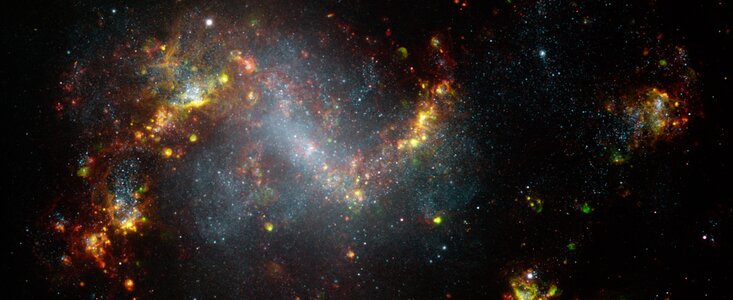Taking A Narrow View Of A Lopsided Galaxy
25 May 2010
The starburst galaxy NGC 1313 is a stellar incubator delivering stars on a scale rarely seen in a single galaxy of its size. Now a striking new Gemini Observatory image reveals the multitudes of glowing gas clouds in this galaxy’s arms. These colorful clouds are the tell-tale sign of star-formation in this prolific star factory.
Because the clouds of gas in stellar nurseries emit light from ionized gas they shine brightly in very specific colors (or wavelengths) so narrow-band filters were used on the Gemini Multi-Object Spectrograph on the Gemini South telescope in Chile to capture the colorful galactic lightscape. The unprecedented detail and clarity of the image reveals myriad bubbles, shock fronts, star clusters, and sites where massive stars are being born.
Located some 15 million light-years away, NGC 1313 is a late-type barred spiral galaxy. It’s a relatively close galactic neighbor to the Milky Way and has a mysterious past. Generally, starburst galaxies show some signs of interaction with another galaxy and a close galactic encounter is usually responsible for sparking increased levels of star-birth activity. However, NGC 1313 is a neighborless “drifter,” far away from any other packs of galaxies. The cause of its deformed shape and high rate of star formation is not obvious.
In radio studies of the underlying gas distribution aimed at solving the mystery of this galaxy’s active star formation rate it appears that the edge of an expanding “superbubble” is causing gas to pile up and spur the formation of stars. Dr. Stuart Ryder, Australian Gemini Scientist at the Anglo-Australian Observatory who has studied this galaxy extensively explains, “What triggered the superbubble is still a mystery. It would have required about a thousand supernovae to go off in the space of just a few million years, or else something punched its way through the disk and set it off like ripples in a pond.”
Astronomers also speculate that nearby gas clouds may be falling into (or orbiting) the galaxy and this could be prompting localized starbursts. The bottom line is that this galaxy still has a lot of questions for astronomers to answer.
Despite its mysteries, even a casual glance at NGC 1313’s morphology reveals a well-defined bar with twisted, asymmetric spiral arms. While pronounced star formation appears along the outer reaches of both arms, it’s much stronger to the northeast (left on the new Gemini image). Other regions of star formation are nearby, especially to the southwest (right) where they appear disconnected due to the action of the superbubble. Very deep exposures also show extensive turmoil in the outer regions of the galaxy (see: http://www.aao.gov.au/images/deep_html/n1313_d.html). Despite the apparent visual chaos, NGC 1313 has a uniformly rotating disk inclined at 48˚ to our line of sight.
In addition, the galaxy hosts several sources of energetic X-rays from what are called ultra-luminous X-ray sources (ULXs). It is thought that most ULXs are powered by intermediate-mass black holes formed during the demise of large binary star systems. One of them, known as NGC 1313 X-2, appears to be a massive black hole of up to several hundred solar masses. It draws matter from a 12-15 solar mass main-sequence star. Another one, called NGC 1313 X-1, may harbor a black hole twice as massive. The final X-ray source is produced by shock emission from Supernova 1978 K.
In the new Gemini image, three narrow-band filters isolate the various features of ionized hydrogen (red), helium (blue), and oxygen (green). These specific colors dominate star-forming regions where hot gas glows brightly and paints the complex network of clouds spanning thousands of light-years. The galaxy itself extends across about 50,000 light-years (about half the extent of the Milky Way) and is located in the direction of the far southern constellation Reticulum.
Notes
The Gemini Observatory is an international collaboration with two identical 8-meter telescopes. The Frederick C. Gillett Gemini Telescope is located at Mauna Kea, Hawai'i (Gemini North) and the other telescope at Cerro Pachón in northern Chile (Gemini South), and hence provide full coverage of both hemispheres of the sky. Both telescopes incorporate new technologies that allow large, relatively thin mirrors under active control to collect and focus both optical and infrared radiation from space.
The Gemini Observatory provides the astronomical communities in each partner country with state-of-the-art astronomical facilities that allocate observing time in proportion to each country's contribution. In addition to financial support, each country also contributes significant scientific and technical resources. The national research agencies that form the Gemini partnership include: the US National Science Foundation (NSF), the UK Science and Technology Facilities Council (STFC), the Canadian National Research Council (NRC), the Chilean Comisión Nacional de Investigación Cientifica y Tecnológica (CONICYT), the Australian Research Council (ARC), the Argentinean Consejo Nacional de Investigaciones Científicas y Técnicas (CONICET) and the Brazilian Conselho Nacional de Desenvolvimento Científico e Tecnológico CNPq). The observatory is managed by the Association of Universities for Research in Astronomy, Inc. (AURA) under a cooperative agreement with the NSF. The NSF also serves as the executive agency for the international partnership.
Contacts
Peter Michaud
Gemini Observatory
Hilo, HI 96720
Tel: 1 (808) 974-2510
Cell: 1(808) 936-6643
Email: pmichaud@gemini.edu
Antonieta Garcia
Gemini Observatory
La Serena, Chile
Tel: Phone (Desk): 56-51-205628
Email: agarcia@gemini.edu


